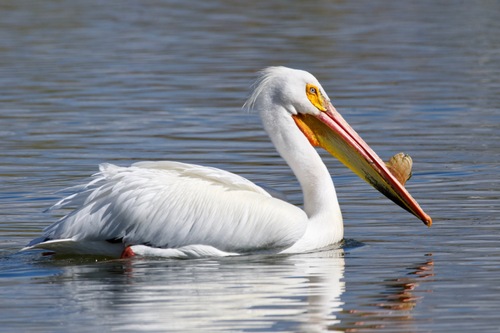
American White Pelican
The American White Pelican (*Pelecanus erythrorhynchos*) is a large, striking bird known for its impressive wingspan and cooperative feeding behavior. Unlike the Brown Pelican, it doesn't dive for fish but instead dips its bill into the water while swimming, often working with other pelicans to corral fish. It plays a crucial role in wetland ecosystems as a top predator, helping to regulate fish populations. While not typically associated with strong cultural symbolism, its impressive size and unique foraging techniques have made it a recognizable and appreciated species across North America.
127-165 cm
Length
244-290 cm
Wingspan
Least Concern
Conservation Status
Distribution
Breeds primarily in interior North America, from southern Canada (British Columbia to Ontario) south to the northern United States (northern California, Nevada, Utah, Colorado, Minnesota). Winters along the Pacific and Gulf coasts of the United States, Mexico, and Central America. Migratory, with some populations traveling thousands of kilometers.
Lifespan
Average lifespan in the wild is 12-14 years, but can exceed 25 years.
American White Pelican's Habitat
Habitat Types
Lakes, Reservoirs, Rivers, Coastal lagoons, Estuaries
Climate Zones
Temperate, Subtropical, Tropical
Adaptations
Their large pouch is a highly specialized adaptation for catching fish. Webbed feet (totipalmate) provide efficient propulsion in water. They can also soar efficiently on thermals, allowing them to travel long distances during migration with minimal energy expenditure.
Variations
No recognized subspecies.
Appearance
Breeding Plumage
Breeding adults develop a yellowish or orange plate on the upper mandible (bill), which is shed after the breeding season. Non-breeding adults have a duller bill color and lack the plate.
Seasonal Feather Changes
Primarily white plumage year-round, with black primary and secondary feathers (flight feathers). Breeding adults may have a yellowish wash on the breast.
Sex Based Plumage Differences
Minimal sexual dimorphism in plumage, although males develop a larger bill plate during breeding.
Notable Features
Large bill with distensible pouch, White plumage with black flight feathers, Orange legs and feet, Prominent bill plate during breeding season
Diet and Feeding
Primary Foods
Small fish, Crustaceans, Amphibians
Foraging Behavior
Often feeds cooperatively, forming a line or semicircle to herd fish into shallow water where they can be easily scooped up. They dip their bills and pouches into the water, rather than diving.
Specializations
The large, expandable pouch is the primary specialization. It acts as a net to capture prey. They also have a small hook at the tip of their upper mandible that may help with grasping slippery fish.
Seasonal Diet Variations
Diet may shift slightly based on prey availability in different regions and seasons, but primarily remains fish-based.
Behavior
Social Structure
Highly social, often found in large flocks, especially during breeding and migration. They form breeding colonies that can contain hundreds or even thousands of pairs.
Communication
Grunts and croaks, Bill-clapping, Visual displays (head and body postures)
Migration
Migratory, traveling in large flocks along established flyways. They rely on thermals to gain altitude and conserve energy during long flights.
Territorial or Group Behaviors
Breeding colonies are defended against predators, but individual pairs do not maintain large territories within the colony. Cooperative foraging is a key group behavior.
Conservation
Threats
Habitat loss and degradation (wetland drainage), Water pollution, Human disturbance at breeding colonies, Entanglement in fishing gear, Disease outbreaks (e.g., West Nile virus)
Protection Programs
Migratory Bird Treaty Act protection, Wetland conservation and restoration efforts, Monitoring of breeding colonies
Local National Laws
Protected under the Migratory Bird Treaty Act in the United States and Canada.
Population Trend
Stable
Population Estimates
Global population estimated to be around 180,000 individuals.
Interesting Facts
They can hold up to 3 gallons of water in their pouch.
This allows them to scoop up large quantities of water and fish.
They are one of the heaviest flying birds in North America.
Despite their size, they are graceful fliers and can soar for long periods.
Young pelicans are fed by regurgitation from their parents.
Parents bring back partially digested fish in their pouches for their chicks.
The oldest recorded American White Pelican lived to be over 26 years old.
Information from bird banding studies provides insights into their lifespan.
Faqs about American White Pelican
Do American White Pelicans dive for fish like Brown Pelicans?
No, American White Pelicans do not dive. They scoop fish from the surface while swimming, often working cooperatively.
Where do American White Pelicans migrate?
They migrate from inland breeding grounds in North America to coastal areas of the southern United States, Mexico, and Central America for the winter.
Are American White Pelicans endangered?
No, they are currently listed as a species of Least Concern by the IUCN, although they face some threats.
What is the purpose of the horn on their bill during breeding season?
The exact function isn't fully understood, but it's thought to play a role in courtship and mate selection, possibly indicating the bird's breeding condition.
Copyright @ Nature Style Limited. All Rights Reserved.
 English
English